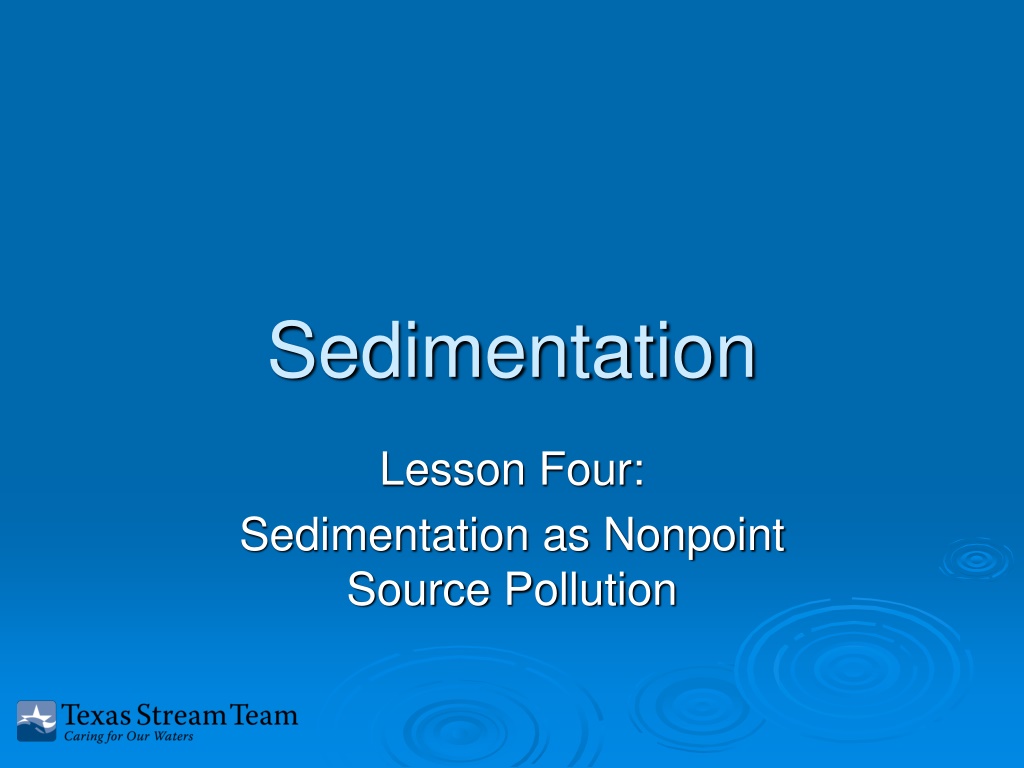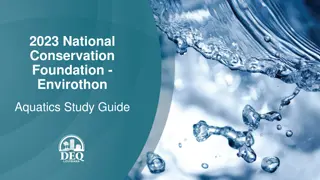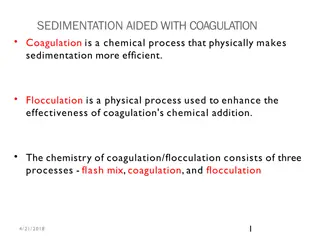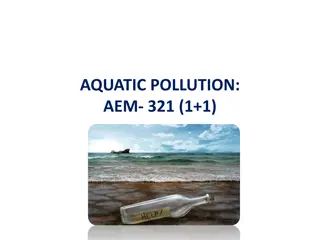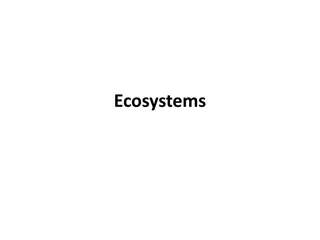Understanding Sedimentation as Nonpoint Source Pollution in Aquatic Ecosystems
Explore the impact of sedimentation as a nonpoint source of pollution on aquatic ecosystems. Learn how sediment affects plant growth, disrupts the food web, and hinders the energy flow within the ecosystem. Discover why sedimentation is detrimental to life and why it is crucial to address this form of pollution for ecosystem health.
Uploaded on Sep 29, 2024 | 0 Views
Download Presentation

Please find below an Image/Link to download the presentation.
The content on the website is provided AS IS for your information and personal use only. It may not be sold, licensed, or shared on other websites without obtaining consent from the author. Download presentation by click this link. If you encounter any issues during the download, it is possible that the publisher has removed the file from their server.
E N D
Presentation Transcript
Sedimentation Lesson Four: Sedimentation as Nonpoint Source Pollution
Lets review what we have observed so far Dirty water and sedimentation Different types of soil are classified by particle size, amount of organic matter and mineral type Soils are part of the rock cycle that results from weathering Smaller particles of soil in water settle out more slowly than larger particles. Some are so small that they remain suspended in water
Sedimentation Why is sedimentation viewed as a nonpoint source of pollution? Because sedimentation is detrimental to life. How?
Aquatic Food Web Oxygen, Carbon Oxygen, Carbon Dioxide, Dioxide, + + Heat and Light Heat and Light Energy Energy Nutrients from the land Foraging Foraging Fish Fish Carnivores Carnivores, , Herbivores Herbivores, , and and Scavengers Scavengers Macroinverte Macroinverte brates brates Herbivores Herbivores, , Carnivores Carnivores and and Omnivores Omnivores Zooplankton Zooplankton Herbivores Herbivores and Carnivores Carnivores Benthos Benthos - - Mud Dwelling Mud Dwelling Scavengers and Scavengers and Decomposers Decomposers Producers Algae - Producers and Floating and Submerged Floating and Submerged Vegetation Vegetation - - Producers Illustrations by
Lets review: What essential part of the ecosystem turns the energy from the sun into food for the animals?
Plants What do plants need to live?
Plants need: Sunshine to carry out photosynthesis Water Soil (nutrients) Oxygen and carbon dioxide How does sediment effect these factors in an aquatic ecosystem?
Sediment in water reduces the sunlight that reaches the plants so the plants cannot make as much food for the rest of the ecosystem.
Remember that the organisms in an ecosystem are interdependent
Animals What do animals need to live?
All animals, including aquatic animals, need: 1. FOOD We have already seen how sediment reduces food In addition, animals cannot see their food as well in cloudy water. 2. OXYGEN dissolved in water Where does the oxygen come from?
Oxygen in water Oxygen comes from the air It also comes from plants in the water when they carry out photosynthesis Since sediment in water reduces photosynthesis, it also reduces the oxygen in the water for the animals
Sediment Sediment can be in the air and in the water. Sediment in the air is called a dust storm or sandstorm. If you were in a sandstorm, how would you protect yourself?
Sandstorm Sandstorm approaching Al Asad, Iraq, just before nightfall on April 27 2005. This is how sediment coming into the water might look to the fish under water.
You would protect your lungs (the way you get oxygen) by covering your nose and mouth
Many aquatic animals get their oxygen through their gills
Aquatic animals cannot cover their gills and sediment harms them
Animals have different structures to perform necessary functions Gills Lungs What is the function of gills? What is the function of lungs? Who has gills? Who has lungs?
Sediment Sediment harms life, so therefore sediment is a pollutant. Review: Where does sediment come from?
Sediment Review Sediment comes from bare soil When wind or water carry soil particles away, we call this erosion What can we do to reduce erosion? Reducing erosion reduces sedimentation
In the next lesson, we will examine ways to reduce erosion and prevent sedimentation
Important terms and concepts Sedimentation is a nonpoint source pollutant Photosynthesis Gills are aquatic animal structures with the function of gathering oxygen Erosion
